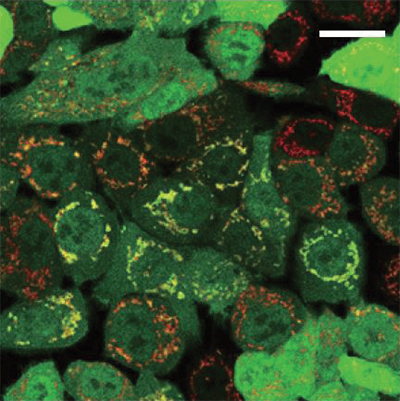JBC: Researchers link new protein to Parkinson鈥檚
Researchers in Japan are reporting new insight into how the Parkinson’s disease-associated protein parkin selects its targets. The finding might improve experimental therapies for Parkinson’s that aim to boost parkin activity.

Cells depend on parkin to help get rid of damaged mitochondria. , published in the Journal of Biological Chemistry, suggests that parkin depends on other proteins, including one called MITOL that has not been linked previously to Parkinson’s disease, to direct it to those damaged mitochondria.
Parkin adds a degradation tag called ubiquitin to proteins on the mitochondrial surface. In some patients with familial Parkinson’s disease, parkin activity is disrupted and bad mitochondria cannot be destroyed. Harmful byproducts from those bad mitochondria can damage neurons. By understanding how parkin works and what goes wrong when it’s mutated, researchers hope also to help patients with other forms of Parkinson’s disease.
While other ubiquitin-tagging proteins, known as E3 ligases, recognize specific amino acid sequences on their substrates, parkin has many known substrates that don’t seem to share a sequence in common. While studying how parkin chooses its substrates, researchers led by Fumika Koyano in at the Tokyo Metropolitan Institute of Medical Science discovered that parkin can tag any lysine-containing protein with ubiquitin — even a bacterial protein not ordinarily found in the cell — as long as it’s present at the surface of the mitochondria.
“Parkin is not regulated by its substrate specificity,” Koyano said of the finding. Instead, control of parkin activity comes from how it is recruited and activated by other proteins.
The discovery that activated parkin is not terribly selective led Koyano and her colleagues to take a closer look at parkin’s recruitment and activation. Some details of that process are well known; for example, a protein called PINK1 is known to boost parkin activity. But Koyano and colleagues discovered a new step that must happen before PINK1 can contribute to parkin activation. They found that parkin acts more rapidly when a first ubiquitin molecule is already present, acting as a seed for the addition of more ubiquitins. In most cases, the researchers found, this seed ubiquitin is added by a protein called MITOL, which had not been linked previously to Parkinson’s.
The research could contribute to the design of new drugs, some of which aim to boost parkin activity to slow the advance of Parkinson’s disease.
“If we achieve upregulation of seed ubiquitylation on mitochondria,” Koyano said, “it might accelerate parkin recruitment and parkin activation to eliminate damaged mitochondria more efficiently.”
Enjoy reading ASBMB Today?
Become a member to receive the print edition four times a year and the digital edition monthly.
Learn moreGet the latest from ASBMB Today
Enter your email address, and we鈥檒l send you a weekly email with recent articles, interviews and more.
Latest in Science
Science highlights or most popular articles

Understanding the roles of extracellular matrix and vesicles in valvular disease
MOSAIC scholar Cassandra Clift uses mass spectrometry and multiomics to study cardiovascular calcification and collagen dysregulation, bridging her background in bioengineering and biology to investigate extracellular vesicles and heart disease.

Lipid profiles reveal sex differences in type 2 diabetes
Researchers explored the lipid profiles of individuals with type 2 diabetes and identified potentially useful lipid biomarkers for this condition.

Serum lipids may predict early diabetes risk
Researchers found that levels of two key fatty acids may predict worsening tolerance for glucose, independent of body fat and insulin levels. In turn, these fatty acids may serve as early T2D biomarkers.

Sex and diet shape fat tissue lipid profiles in obesity
Researchers found that sex hormone levels and diet both influence inflammation and lipid composition in obesity.

Mapping the placenta鈥檚 hormone network
Study uncovers how the placenta actively metabolizes not only glucocorticoids but also novel androgens and progesterones, reshaping our understanding of pregnancy and its complications.

Biochemists and molecular biologists sweep major 2025 honors
Recent Nobel, MacArthur and Kimberly Prize honorees highlight the power of biochemistry and molecular biology to drive discovery, including immune tolerance, vaccine design and metabolic disease, and to advance medicine and improve human health.

